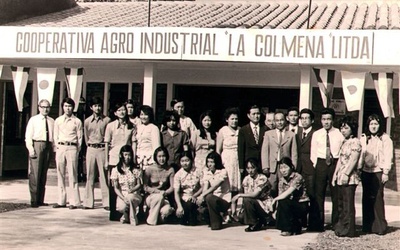
Emi Kasamatsu
Emi Kasamatsu is a Paraguayan Nisei, researcher on Japanese immigration to Paraguay and the Americas. He has published two books on the subject and other publications, such as Discover Nikkei and INRP from the Japanese American National Museum in Los Angeles, USA.
He has given several conferences at the JOCHI and Nanzan Universities in Japan and the UCLA in the USA and at the Pan-American Nikkei Conventions in about ten countries and at the Memorial of the Americas in Brazil, on immigration issues and the Nikkei in Latin America.
She has a Bachelor of Arts and a Master in Gender and Development from the National University of Asunción, a Post Graduate Degree in Governance and Leadership at the International Institute of Governance of Catalonia, Spain, in Research Methodology and a Diploma in Social and Solidarity Economy at REPEM.
Last updated April 2014
Stories from This Author
El idioma japonés como fundamento de la identidad y la preservación de la tradiciones y cultura
April 24, 2007 • Emi Kasamatsu
A través de la observación minuciosa, es importante cerciorar que los Nikkei del Paraguay junto con los de Santa Cruz de la Sierra y San Juan de Bolivia son los que quizás hablen mejor y en número el idioma japonés en el continente americano. El conocimiento del idioma hace que conserve el estilo de vida y costumbres y hasta en los caracteres y la filosofía de vida de sus ancestros. Para muchos Nisei, el idioma japonés es el lenguaje del …
La importancia de la asociatividad entre los japoneses, formación de asociaciones, federaciones y entidades de beneficencia y deportivas
April 10, 2007 • Emi Kasamatsu
Se dice que tres japoneses se reúnen y se forma una asociación. Tal es la necesidad de agruparse para la realización de un objetivo común en la búsqueda de beneficios que redunde al grupo y su posterior trascendencia hacia una comunidad. Esta forma asociativa esta inserto profundamente en el alma de los japoneses con el lema “dos cabezas valen más que una” y el valor de trabajar en equipo y lograr el equilibrio entre todos. Se puede comparar el trabajo …
Mujeres del mundo donde están situadas y las mujeres Nikkei
March 28, 2007 • Emi Kasamatsu
Desde los tiempos inmemoriales, remontando al génesis de la creación humana, según la concepción occidental subraya a los primeros hombres sobre la tierra a: Adán y Eva, en ella está explícita la condición inferior de la mujer con respecto al hombre. ¿Habría sido este el plan divino de tal manera que el hombre sea el amo y señor de la tierra y es el que rige los destinos del mundo? Eva, como dice el libro sagrado ha sido creada de …
La contribución en la agricultura de los inmigrantes japoneses
March 13, 2007 • Emi Kasamatsu
La apertura de la inmigración japonesa en el Paraguay, ocurrido en el año 1936, se concretó bajo el gobierno del Coronel Rafael Franco, para el efecto se estableció la siguiente cláusula en la que el gobierno del Paraguay aceptada a 100 familias japonesas agrícolas en forma experimental. La Compañía Colonizadora del Paraguay, PARATAKU*, establecida para tal efecto en el país. Para un adecuado ordenamiento en el desarrollo de la colonia, había traído primero a inmigrantes guías desde el Brasil de …
La situación de la inmigración japonesa de la post segunda guerra mundial
Feb. 20, 2007 • Emi Kasamatsu
Muchos fueron las dificultades, los sufrimientos y los vejámenes que habían tenido que pasar los inmigrantes japoneses del continente americano como consecuencia del ingreso del Japón en la Segunda Guerra Mundial, con el ataque en Pearl Harbour perpetrado el 7 de diciembre de 1941. Sin embargo, debido al espacio que me concede me quiero referir solamente, el resultado del episodio bélico de los países de la América Latina donde existen las inmigraciones japonesas. Cada uno de estos países había reaccionado …
La importancia de Yamato Damashi y el Yamato Nadeshiko
Jan. 18, 2007 • Emi Kasamatsu
En el año 660 a.c. aparece en escena el primer Emperador del Japón con el nombre de Jimmu que significa “Guerrero Divino” y se establece en las llanuras de Yamato con el nombre de Kammu Yamato Iware No Hiko que vendría a ser el descendiente de la Diosa del Sol, Amaterasu. Se tejió varias conjeturas en la veracidad de esa descendencia en la actualidad. Según Whitney Hall la hegemonía de la dinastía de los Yamato estableció ciertas estructuras jerárquicas; por …
Luces y sombras de los primeros japoneses de la colmena
Dec. 20, 2006 • Emi Kasamatsu
Como se ha informado recientemente, Paraguay fue uno de los últimos países de la América del Sur en donde ingresaron los inmigrantes japoneses (1936). Tal vez debido a que Paraguay por su mediterraneidad, era un país sin costas en el mar. La ausencia del mar era una condición negativa para el desarrollo vital de las personas y para cualquier relacionamiento con el exterior como también para las adecuadas transacciones comerciales. La Colmena fue la primera colonia japonesa del Paraguay, se …
Disposiciones situacionales y prohibiciones de la entrada de inmigrantes de raza amarilla
Dec. 6, 2006 • Emi Kasamatsu
Antecedentes históricos Los países europeos que han empezado a emigrar a otras regiones desde los comienzo del siglo XIX, se calcula que, hasta el año 1932 emigraron unas 80 millones de personas. Los países asiáticos estaban prácticamente aislados del contexto mundial, empezaron a movilizarse primero los chinos en el año 1840. Mas tarde con la restauración del Imperio Japonés con el Emperador Meiji que dio lugar la apertura del país al mundo exterior, partieron en el año 1886 para Hawai, …
Trayectoria de los primeros japoneses en el Paraguay
Nov. 22, 2006 • Emi Kasamatsu
Haciendo una reseña histórica acerca del movimiento de los japoneses al exterior y sobre todo a las Americas, fue relativamente nula en los siglos XV a XVI cuando los barcos Europeos ya habían hecho su conquista y expansión en las nuevas tierra de América y también del lejano oriente. Para estos conquistadores eran “bárbaros”, todos los que no pertenecían a la raza blanca europea. Sin embargo, la conceptualización de la barbaridad para los japoneses con respecto a extranjeros era también …
La inmigración japonesa en el Paraguay: Trayectoria de los 70 años
Nov. 4, 2006 • Emi Kasamatsu
Las inmigraciones japonesas en las Americas datan desde los año 1868 a Hawai a donde que se translaron como braseros en las plantaciones de caña de azucar. Desde entonces se puede constatar la existencia de los japoneses y nikkei que alcanzan un total de unos 2.400.000 personas en mas quince paises de todo el continente. Indudablemente el asentamiento en un lugar extraño con idiomas y culturas diametramente opuestas y las condiciones laborales con mucha informalidad habrían sido una desventaja tremenda …





